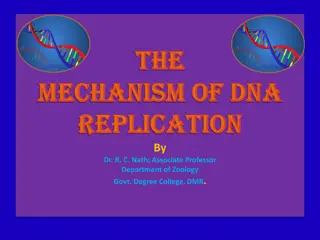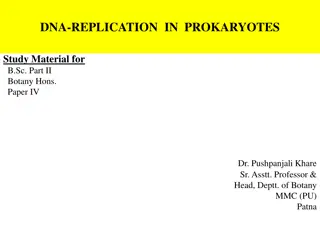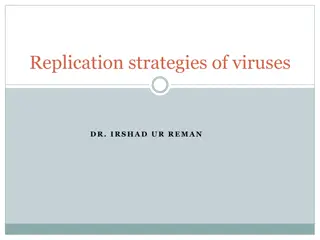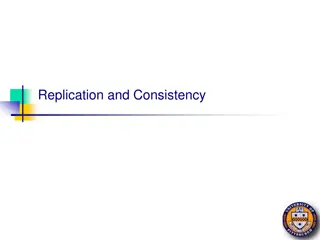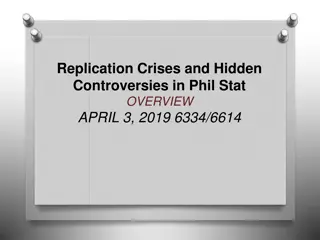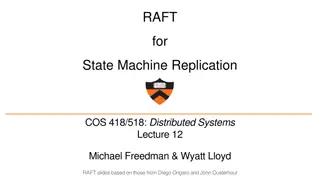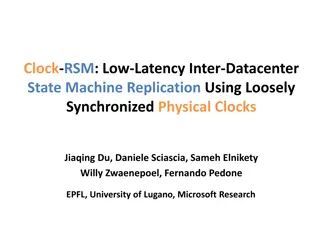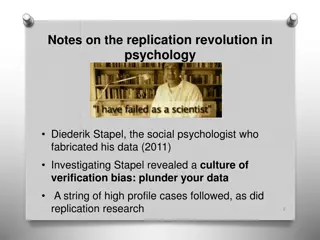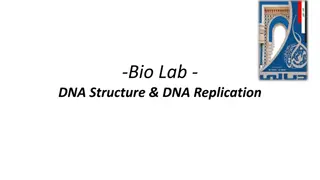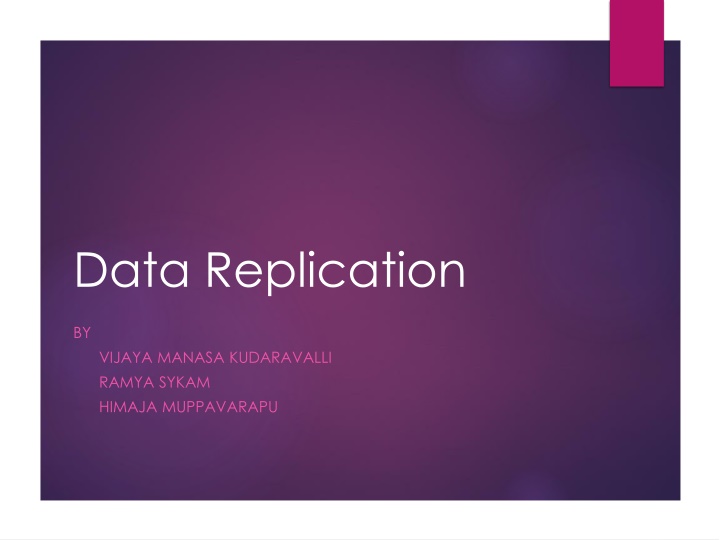
Data Replication: Benefits and Considerations
Explore the concept of data replication, including its importance in improving data availability, reducing response times, and supporting scalability. Learn about the purpose of data replication, its application requirements, an example scenario, and factors influencing replication protocol design.
Download Presentation

Please find below an Image/Link to download the presentation.
The content on the website is provided AS IS for your information and personal use only. It may not be sold, licensed, or shared on other websites without obtaining consent from the author. If you encounter any issues during the download, it is possible that the publisher has removed the file from their server.
You are allowed to download the files provided on this website for personal or commercial use, subject to the condition that they are used lawfully. All files are the property of their respective owners.
The content on the website is provided AS IS for your information and personal use only. It may not be sold, licensed, or shared on other websites without obtaining consent from the author.
E N D
Presentation Transcript
Data Replication BY VIJAYA MANASA KUDARAVALLI RAMYA SYKAM HIMAJA MUPPAVARAPU
2 DATA REPLICATION Data Replication is the process of storing data in more than one site or node. It is useful in improving the availability of data. It is simply copying data from a database from one server to another server so that all the users can share the same data without any inconsistency. The result is a distributed database in which users can access data relevant to their tasks without interfering with the work of others. Data replication encompasses duplication of transactions on an ongoing basis, so that the replicate is in a consistently updated state and synchronized with the source. However in data replication data is available at different locations, but a particular relation has to reside at only one location.
3 Purpose of Data Replication 1. Distributed DBMS may remove single points of failure by replicating data so that data items may be accessible from multiple sites. Consequently even when some sites are down then data may be accessible from other sites. 2. Performance: One of the major contributions of response time is the communication overhead. Replication enables us to locate the data closer to their access points, thereby localizing most of the access that contributes to a reduction in response time. 3. Scalability: As system grow geographically and in terms of the number of sites ,replication allows for way to support this growth with acceptable response times.
4 Cont Application requirements: Finally, replication may be dictated by the applications, which may wish to maintain multiple data copies as part of their operational specifications.
5 Example Consider the execution model in replicated databases. Each replicated data item has x number of copies as x1,x2,x3, ..,xn. x is a logical data item and its copies are a replica. Replica control protocol is responsible for mapping these operations to read or write the physical data items x1,x2, xn. The operation to read or write will depend according to the specific replication protocol.
6 Factors affecting the design of replication protocol Database design : A database may be fully or partially replicated. In case of a partially replicated the number of physical items for the number of logical items may vary and some data items may even be non replicated. In this case of that can access only non replicated data items that are local transactions and their replication is not a concern . Transaction that has replicated data have to be executed multiple times and are known as global transactions.
7 Cont.. Data consistency: When global transaction update copies of data items at different sites, the values of copies may be different at a given point of time. A replicated database is said to be mutually consistent state if all the replicas of each of its data items have identical values. The differences is how tightly synchronized the replicas have to be. Some ensure that replicas are mutually consistent when an update transaction commits thus these are known as the consistency criteria.
8 Cont.. Where updates are performed: A fundamental design decision in designing a replication protocol is where the database updates are performed. These techniques are characterized as centralized if they perform the update on a master copy versus distributed if they updates over any replica. Centralized techniques can be further observed on a single master when there is only one master database copy in the system or a primary copy where master copy of each data item may be different.
9 Update propagation Once the updates are performed on the replica the next decision is how the updates are propagated to others. The alternatives are identified in Eager versus Lazy. Eager techniques perform all of the updates within the context of global transaction that has initiated the write operations. Thus when the transaction commits it s updates will have been applied to all of the copies . They are also identified based on push each write to other replica,some push each write operation individually while others batch the write and propagate them to the commit point. Lazy techniques propagate the updates sometimes after initiating transaction has been commited.
10 Cont Degree of replication transperancy: Certain replication protocol require each user application to know the master site where the transaction operations are to be submitted. These protocol provide only the limited replication protocol transperancy to user applications. While others provide the full replication transperancy by involving the Transaction Manager at each site. In this case the user application submit transactions to their local TM s rather than the master site.
11 Consistency of Replicated Databases There are two issues related to the consistency of the replicated databases. Mutual consistency Transaction consistency
12 Mutual Consistency It deals with the convergence of values of physical data items corresponding to one logical data item. Mutual consistency can be either strong or weak. Strong mutual consistency: requires all the copies of data item have the same value at the end of the execution of an update transaction. This achieved by a variety of means but the execution of 2PC at the commit point of an update transaction is a common way to achieve the strong mutual consistency.
13 Cont.. Weak mutual consistency: it doesnot require the values of the replicas of data item to be identical when an update transaction terminates. What is required is that if update activity causes for sometime values eventually become identical. this also known as eventual consistency.
14 Another definition to eventual consistency: A replicated [data item] is eventually consistent when it meets the following conditions, assuming that all replicas start from the same initial state.
15 Epsilon serializability Epsilon serializability allows a query to see inconsistent data while replicas are being updated, but requires that the replicas converge to a one- copy serializable state once the updates are propagated to all of the copies. users should be allowed to specify freshness constraints that are suitable for particular applications and the replication protocols should enforce these.
16 types of freshness constraints that can be specified are the following: Time-bound constraints. Users may accept divergence of physical copy values up to a certain time: xi may reflect the value of an update at time t while x j may reflect the value at t and this may be acceptable. Value-bound constraints. It may be acceptable to have values of all physical data items within a certain range of each other. The user may consider the database to be mutually consistent if the values do not diverge more than a certain amount (or percentage)
17 Cont.. Drift constraints on multiple data items. For transactions that read multiple data items, users may be satisfied if the time drift between the update timestamps of two data items is less than a threshold (i.e., they were updated within that threshold) in the case of aggregate computation, if the aggregate computed over a data item is within a certain range of the most recent value
Mutual Consistency versus Transaction Consistency 18 . Mutual consistency refers to the replicas converging to the same value, while transaction consistency requires that the global execution history be serializable. It is possible for a replicated DBMS to ensure that data items are mutually consistent when a transaction commits, but the execution history may not be globally serializable.
19 Example: Consider three sites (A, B, and C) and three data items (x,y, z) that are distributed as follows: Site A hosts x, Site B hosts x,y, Site C hosts x, y, z. We will use site identifiers as subscripts on the data items to refer to a particular replica. Now consider the following three transactions: T1: x 20 T2: Read(x) T3: Read(x) Write(x) y x+ y Read(y) Commit Write(y) z (x y)/100 Commit Write(z) Commit
20 Cont.. We are assuming a transaction execution model where transactions can read their local replicas, but have to update all of the replicas. Assume that the following three local histories are generated at the sites: HA = {W1(xA),C1} HB = {W1(xB),C1,R2(xB),W2(yB),C2} HC = {W2(yC),C2,R3(xC),R3(yC),W3(zC),C3,W1(xC),C1}
21 Cont.. The serialization order in HB is T1 T2 while in HC it is T2 T3 T1. Therefore, the global history is not serializable. However, the database is mutually consistent. Assume, for example, that initially xA = xB = xC = 10, yB = yC = 15, and zC = 7.With the above histories, the final values will be xA = xB = xC = 20, yB = yC = 35, zC = 3.5. All the physical copies (replicas) have indeed converged to the same value.
22 Cont Consider two sites (A and B), and one data item (x) that is replicated at both sites (xA and xB). Further consider the following two transactions: T1: Read(x) T2: Read(x) x x+ 5 x x 10 Write(x) Write(x) Commit Commit
23 Cont.. Assume that the following two local histories are generated at the two sites (again using the execution model of the previous example): HA = {R1(xA),W1(xA),C1,R2(xA),W2(xA),C2} HB = {R2(xB),W2(xB),C2,R1(xB),W1(xB),C1} Although both of these histories are serial, they serialize T1 and T2 in reverse order thus the global history is not serializable. Furthermore, the mutual consistency is violated as well. Assume that the value of x prior to the execution of these transactions was 1. At the end of the execution of these schedules, the value of x is 60 at site A while it is 15 at site B. Thus, in this example, the global history is non-serializable and the databases are mutually inconsistent.
24 Cont.. Given the above observation, the transaction consistency criterion is extended in replicated databases to define one-copy serializability. One- copy serializability (1SR) states that the effects of transactions on replicated data items should be the same as if they had been performed one at-a-time on a single set of data items. In other words, the histories are equivalent to some serial execution over non-replicated data items.
25 Update Management Strategies: the replication protocols can be classified according to when the updates are propagated to copies (eager versus lazy) and where updates are allowed to occur (centralized versus distributed). Eager Update Propagation Lazy Update Propagation
26 Eager Update Propagation The eager update propagation approaches apply the changes to all the replicas within the context of the update transaction. Consequently, when the update transaction commits, all the copies have the same value. Typically, eager propagation techniques use 2PC at commit point. Eager propagation may use synchronous propagation of each update by applying it on all the replicas at the same time (when the W rite is issued), or deferred propagation whereby the updates are applied to one replica when they are issued, but their application on the other replicas is batched and deferred to the end of the transaction. Deferred propagation can be implemented by including the updates in the Prepare-to- Commit message at the start of 2PC execution.
27 Advantages and Disadvantages The advantages of eager update propagation are threefold. First, they typically ensure that mutual consistency is enforced using 1SR; therefore, there are no transactional inconsistencies. Second, a transaction can read a local copy of the data item (if a local copy is available) and be certain that an up-to-date value is read. Thus, there is no need to do a remote read. The main disadvantage of eager update propagation is that a transaction has to update all the copies before it can terminate. This has two consequences. First, the response time performance of the update transaction suffers, since it typically has to participate in a 2PC execution, and because the update speed is restricted by the slowest machine. Second, if one of the copies is unavailable, then the transaction cannot terminate since all the copies need to be updated. if it is possible to differentiate between site failures and network failures, then one can terminate the transaction as long as only one replica is unavailable (recall that more than one site unavailability causes 2PC to be blocking), but it is generally not possible to differentiate between these two types of failures.
28 Lazy Update Propagation In lazy update propagation the replica updates are not all performed within the context of the update transaction. In other words, the transaction does not wait until its updates are applied to all the copies before it commits it commits as soon as one replica is updated. The propagation to other copies is done asynchronously from the original transaction, by means of refresh transactions that are sent to the replica sites some time after the update transaction commits. A refresh transaction carries the sequence of updates of the corresponding update transaction. Lazy propagation is used in those applications for which strong mutual consistency may be unnecessary and too restrictive.
29 Cont.. These applications may be able to tolerate some inconsistency among the replicas in return for better performance. Examples of such applications are Domain Name Service (DNS), databases over geographically widely distributed sites, mobile databases, and personal digital assistant databases .In these cases, usually weak mutual consistency is enforced
30 Advantages and Disadvantages The primary advantage of lazy update propagation techniques is that they generally have lower response times for update transactions, since an update transaction can commit as soon as it has updated one copy. The disadvantages are that the replicas are not mutually consistent and some replicas may be out- of-date, and, consequently, a local read may read stale data and does not guarantee to return the up- to-date value.
31 Centralized Techniques Centralized update propagation techniques require that updates are first applied at a master copy and then propagated to other copies (which are called slaves). The site that hosts the master copy is similarly called the master site, while the sites that host the slave copies for that data item are called slave sites. In some techniques, there is a single master for all replicated data. We refer to these as single master centralized techniques. In other protocols, the master copy for each data item may be different (i.e., for data item x, the master copy may be xi stored at site Si, while for data item y, it may be y j stored at site S j). These are typically known as primary copy centralized techniques
32 Advantages and Disadvantages The advantages of centralized techniques are two-fold. First, application of the updates is easy since they happen at only the master site, and they do not require synchronization among multiple replica sites. there is the assurance that at least one site the site that holds the master copy has up-to-date values for a data item. These protocols are generally suitable in data warehouses and other applications where data processing is centralized at one or a few master sites. The primary disadvantage is that, as in any centralized algorithm, if there is one central site that hosts all of the masters, this site can be overloaded and can become a bottleneck. Distributing the master site responsibility for each data item as in primary copy techniques is one way of reducing this overhead, but it raises consistency issues,in particular with respect to maintaining global serializability in lazy replication techniques since the refresh transactions have to be executed at the replicas in the same serialization order. We discuss these further in relevant sections.
33 Distributed Techniques Distributed techniques apply the update on the local copy at the site where the update transaction originates, and then the updates are propagated to the other replica sites. These are called distributed techniques since different transactions can update different copies of the same data item located at different sites. They are appropriate for collaborative applications with distributive decision/operation centers. They can more evenly distribute the load, and may provide the highest system availability if coupled with lazy propagation techniques.
34 Replication Protocols In the previous section, we discussed two dimensions along which update management techniques can be classified. W rite(x) causes an update of the master copy (i.e., executed as W rite(xM)) by first obtaining a write lock and then performing the write operation. These dimensions are orthogonal; therefore four combinations are possible: eager centralized, eager distributed, lazy centralized, and lazy distributed. A fully replicated database, which means that all update transactions are global. We further assume that each site implements a 2PL-based concurrency control technique.
35 Eager Centralized Protocols In eager centralized replica control, a master site controls the operations on a data item. These protocols are coupled with strong consistency techniques, so that updates to a logical data item are applied to all of its replicas within the context of the update transaction, which is committed using the 2PC protocol (although non-2PC alternatives exist as we discuss shortly). The two design parameters that we discussed earlier determine the specific implementation of eager centralized replica protocols: The first parameter, refers to whether there is a single master site for all data items (single master), or different master sites for each, or, more likely, for a group of data items (primary copy) The second parameter indicates whether each application knows the location of the master copy (limited application transparency) or whether it can rely on its local TM for determining the location of the master copy (full replication transparency).
36 Single Master with Limited Replication Transparency The simplest case is to have a single master for the entire database with limited replication transparency so that user applications know the master site. Global update transactions are submitted directly to the master site more specifically, to the transaction manager (TM) at the master site. At the master, each Read(x) operation is performed on the master copy (i.e., Read(x) is converted to Read(xM), where M signifies master copy) and executed as follows: a read lock is obtained on xM, the read is performed, and the result is returned to the user. W rite(x) causes an update of the master copy (i.e., executed as W rite(xM)) by first obtaining a write lock and then performing the write operation.
37 Single Master with Limited Replication Transparency The user application may submit a read-only transaction to any slave site. The execution of read- only transactions at the slaves can follow the process of centralized concurrency control algorithms, such as C2PL, where the centralized lock manager resides at the master replica site. Implementations within C2PL require minimal changes to the TM at the non-master sites, primarily to deal with the W rite operations as described above, and its consequences . The Read can then be executed at the master and the result returned to the application, or the master can simply send a lock granted message to the originating site, which can then execute the Read on the local copy. A Read may read data item values at a slave either before an update is installed or after. The fact that a read transaction at one slave site may read the value of one replica before an update while another read transaction reads another replica at another slave after the same update
38 Single Master with Limited Replication Transparency T1: Write(x) T2: Read(x) T3: Read(x) Commit Commit Commit Assume that T2 is sent to slave at Site B and T3 to slave at Site C. Assume that T2 reads x at B [Read(xB)] before T1 s update is applied at B, while T3 reads x at C [Read(xC)] after T1 s update at C. Then the histories generated at the two slaves will be as follows: HB = {R2(x),C2,W1(x),C1} HC = {W1(x),C1,R3(x),C3}
39 Single Master with Limited Replication Transparency The serialization order at Site B is T2 T1, while at Site C it is T1 T3. The global serialization order, therefore, is T2 T1 T3 when a slave site receives a Read(x), it obtains a local read lock, reads from its local copy (i.e., Read(xi)) and returns the result to the user application; this can only come from a read-only transaction. When it receives a Write(x), if the Write is coming from the master site, then it performs it on the local copy (i.e., Write(xi)). If it receives a W rite from a user application, then it rejects it, since this is obviously an error given that update transactions have to be submitted to the master site.
40 Single Master with Full Replication Transparency Single master eager centralized protocols require each user application to know the master site, and they put significant load on the master that has to deal with the Read operations within update transactions as well as acting as the coordinator for these transactions during 2PC execution. The update transactions are not submitted to the master, but to the TM at the site where the application runs . This TM can act as the coordinating TM for both update and read-only transactions. Applications can simply submit their transactions to their local TM, providing full transparency . The coordinating TM may only act as a router , forwarding each operation directly to the master site.
41 Single Master with Full Replication Transparency An alternative implementation may be as follows. The coordinating TM sends each operation, as it gets it, to the central (master) site. If the operation is a Read(x), then the centralized lock manager can proceed by setting a read lock on its copy of x (call it xM) on behalf of this transaction and informs the coordinating TM that the read lock is granted. The coordinating TM can then forward the Read(x) to any slave site that holds a replica of x .The read can then be carried out by the data processor (DP) at that slave . If the operation is a W rite(x), then the centralized lock manager (master) proceeds as follows: (a) It first sets a write lock on its copy of x. (b) It then calls its local DP to perform the Write on its own copy of x (i.e., converts the operation to W rite(xM)). (c) Finally, it informs the coordinating TM that the write lock is granted
42 Single Master with Full Replication Transparency To demonstrate how eager algorithms combine replica control and concurrency control, how the Transaction Management algorithm for the coordinating TM and the Lock Management algorithm for the master site. The algorithm fragments that have given, the LM simply sends back a Lock granted message and not the result of the update operation. Consequently, when the update is forwarded to the slaves by the coordinating TM, they need to execute the update operation themselves. This is sometimes referred to as operation transfer. The alternative is for the Lock granted message to include the result of the update computation, which is then forwarded to the slaves who simply need to apply the result and update their logs. This is referred to as state transfer .
43 Eager Single Master Modifications to C2PL-TM begin . . . if lock request granted then if op.Type = W then S set of all sites that are slaves for the data item else S any one site which has a copy of data item DPS(op) {send operation to all sites in set S} else inform user about the termination of transaction end
44 Eager Single Master Modifications to C2PL-TM begin . . . switch op.Type do case R or W {lock request; see if it can be granted} find the lock unit lu such that op.arg lu ; if lu is unlocked or lock mode of lu is compatible with op.Type then set lock on lu in appropriate mode on behalf of transaction op.tid ; if op.Type = W DPM(op) {call local DP (M for master ) with operation} send Lock granted to coordinating TM of transaction else put op on a queue for lu end
45 Primary Copy with Full Replication Transparency The requirement that there is one master for all data items; each data item can have a different master. In this case, for each replicated data item, one of the replicas is designated as the primary copy. There is no single master to determine the global serialization order, so more care is required. In the case of fully replicated databases, any replica can be primary copy for a data item, however for partially replicated databases, limited replication transparency option only makes sense if an update transaction accesses only data items whose primary sites are at the same site. The application program cannot forward the update transactions to one master; it will have to do it operation-by-operation, and, furthermore, it is not clear which primary copy master would serve as the coordinator for 2PC execution. Therefore, the reasonable alternative is the full transparency support, where the TM at the application site acts as the coordinating TM and forwards each operation to the primary site of the data item that it acts on.
47 Primary Copy with Full Replication Transparency . A very early proposal is the primary copy two-phase locking (PC2PL) algorithm proposed for the prototype distributed version of INGRES . PC2PL is a straightforward extension of the single master protocol discussed above in an attempt to counter the latter s potential performance problems . Basically, it implements lock managers at a number of sites and makes each lock manager responsible for managing the locks for a given set of lock units for which it is the master site. The transaction managers then send their lock and unlock requests to the lock managers that are responsible for that specific lock unit. Thus the algorithm treats one copy of each data item as its primary copy. . primary copy approach demands a more sophisticated directory at each site, but it also improves the previously discussed approaches by reducing the load of the master site without causing a large amount of communication among the transaction managers and lock managers.
48 Eager Distributed Protocols In eager distributed replica control, the updates can originate anywhere, and they are first applied on the local replica, then the updates are propagated to other replicas. If the update originates at a site where a replica of the data item does not exist, it is forwarded to one of the replica sites, which coordinates its execution. All of these are done within the context of the update transaction, and when the transaction commits, the user is notified and the updates are made permanent. The sequence of operations for one logical data item x with copies at sites A, B, C and D, and where two transactions update two different copies
49 Eager Distributed Protocols
50 Eager Distributed Protocols The critical issue is to ensure that concurrent conflicting W rites initiated at different sites are executed in the same order at every site where they execute together . Consequently, read operations can be performed on any copy, but writes are performed on all copies within transactional boundaries using a concurrency control protocol.




